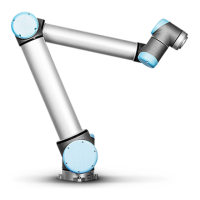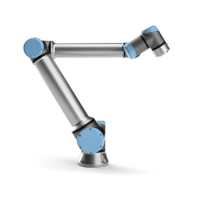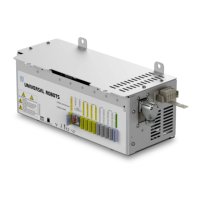The tolerance and unit for each limit are listed at the end of the row that corresponds to it. When
a program is running, the speed of the robot arm is automatically adjusted in order to not exceed
any of the entered values minus the tolerance (see1.20.4. Toleranceson page90). Note that the
minus sign displayed with each tolerance value is only there to indicate that the tolerance is
subtracted from the actual entered value. Nevertheless, should the angular velocity of some joint
exceed the entered value (without tolerance), the safety system performs a Stop Category 0.
Position Range
This screen defines the position range for each joint. This is done by tapping the corresponding
text fields and entering new values for the lower and upper joint position boundary. The entered
interval must fall within the values listed in the column titled Range and the lower boundary
cannot exceed the upper boundary.
Note: The fields for limits in Reduced mode are disabled when neither a safety plane nor a
configurable input is set to trigger it (see1.20.13. Safety I/Oon page104 for more
details).1.20.12. Boundariesbelow and
The tolerances and unit for each limit are listed at the end of the row that corresponds to it. The
first tolerance value applies to the minimum value and the second applies to the maximum
value. Program execution is aborted when the position of a joint is about to exceed the range
resulting from adding the first tolerance to the entered minimum value and subtracting the
second tolerance from the entered maximum value, if it continues moving along the predicted
trajectory. Note that the minus sign displayed with the tolerance value is only there to indicate
that the tolerance is subtracted from the actual entered value. Nevertheless, should the joint
position exceed the entered range, the safety system performs a Stop Category 0.
1.20.12. Boundaries
In this tab you can configure boundary limits consisting of safety planes and a limit on the
maximum allowed deviation of the robot tool orientation. It is also possible to define planes that
trigger a transition into Reduced mode.
Safety planes can be used to restrict the allowed workspace of the robot by enforcing that the
robot TCP stay on the correct side of the defined planes and not pass through them. Up to eight
safety planes can be configured. The constraint on the orientation of tool can be utilized to
ensure that the robot tool orientation does not deviate more than a certain specified amount from
a desired orientation.
WARNING
Defining safety planes only limits the TCP and not the overall limit for the robot
arm. This means that although a safety plane is specified, it does not guarantee
that other parts of the robot arm will obey this restriction.
The configuration of each boundary limit is based on one of the features defined in the current
robot installation (see1.23.12. Installation → Featureson page140).
User Manual 97 UR10
Copyright © 2009–2020 by UniversalRobotsA/S. All rights reserved.

